Planned in Mode:
- 3 campaign: Partisans, Ustasha and Chetnik's
- 5 historical chapters for each campaign
- 5 historical missions for each chapters
- ultarealistic units, objects and buildings
and much more.
We surently looking for:
- Texture editor
- Level designer
- Map editor
- Lua programmer
If you're interested you must contract developer team !
The invasion of Yugoslavia, also known as the April War or Operation 25, was a German-led attack on the Kingdom of Yugoslavia by the Axis powers which began on 6 April 1941 during World War II. The order for the invasion was put forward in "Führer Directive No. 25", which Adolf Hitler issued on 27 March 1941.
The invasion commenced with an overwhelming air attack on Belgrade and facilities of the Royal Yugoslav Air Force (VVKJ) by the Luftwaffe (German Air Force) and attacks by German land forces from southwestern Bulgaria. These attacks were followed by German thrusts from Romania, Hungary and the Third Reich (modern-day Austria). Italian forces were limited to air and artillery attacks until 11 April, when the Italian army attacked towards Ljubljana (in modern-day Slovenia and through Istria and Lika and down the Dalmatian coast. On the same day, Hungarian forces entered Yugoslav Bačka and Baranya, but like the Italians they faced practically no resistance. A Yugoslav attack into the northern parts of the Italian protectorate of Albania met with initial success, but was inconsequential due to the collapse of the rest of the Yugoslav forces.
The invasion ended with the unconditional surrender of the Royal Yugoslav Army on 17 April 1941. Yugoslavia was then occupied and partitioned by the Axis powers. Some areas of Yugoslavia were annexed by neighboring Axis countries, some areas remained occupied, and in other areas Axis puppet states such as the Independent State of Croatia (Nezavisna Država Hrvatska, or NDH) were created. Along with Italy's failed invasion of Greece on 28 October 1940, and the German-led invasion of Greece (Operation Marita) and invasion of Crete (Operation Merkur), the invasion of Yugoslavia was part of the German Balkan Campaign (German: Balkanfeldzug).
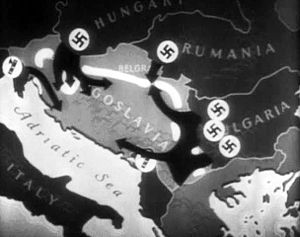
Background
In October 1940, Fascist Italy had attacked Greece only to be forced back into Albania. German dictator Adolf Hitler recognised the need to go to the aid of his ally, Italian dictator Benito Mussolini. Hitler did this not only to restore diminished Axis prestige, but also to prevent the United Kingdom from being able to bomb the Romanian oilfields from which Germany obtained most of her oil.Following agreements with Hungary, Romania and Bulgaria that they would join the Axis, Hitler put pressure on Yugoslavia to join the Tripartite Pact. The Regent, Prince Paul of Yugoslavia and his cabinet, succumbed to this pressure on 25 March 1941. However, this move was deeply unpopular with the military and some segments of the public A coup d'état
was launched on 27 March 1941 by mainly Serbian military officers, and
the Regent was replaced on the throne by the under-age prince, who was
declared of age and proclaimed King Peter II of Yugoslavia.
Upon hearing news of the coup in Yugoslavia, Hitler called his military
advisers to Berlin on 27 March. Hitler took the coup as a personal
insult, and was so angered that he was determined "without waiting for
possible declarations of loyalty of the new government to destroy
Yugoslavia militarily and as a nation.
Hungary
Hungary had joined the Tripartite Pact on 20 November 1940. The
following month on 12 December it also concluded a treaty with the
Kingdom of Yugoslavia calling for "permanent peace and eternal
friendship". The Hungarian leadership was split after Germany's War Directive 25 was delivered on 27 March 1941. Regent Miklós Horthy and the military favoured taking part in the invasion of Yugoslavia and mobilized the following day. Prime Minister Pál Teleki
sought to prevent German troops passing through Hungary and cited the
peace treaty with Yugoslavia as an impediment to cooperation with the
Germans.
On 3 April, War Directive 26 was issued detailing the plan of attack
and command structure for the invasion as well as promising Hungary
territorial gains. The same day Teleki committed suicide by shooting himself. Horthy,
seeking a compromise, informed Hitler that evening that Hungary would
abide by the treaty, though it would likely cease to apply should
Croatia secede and Yugoslavia cease to exist. Upon the proclamation of an Independent State of Croatia
in Zagreb on 10 April this scenario was realized and Hungary joined the
invasion, its army crossing into Yugoslavia the following day.
The Royal Yugoslav Armed Forces
Equipment and organization
Formed after World War I, the Royal Yugoslav Army
was still largely equipped with weapons and material from that era,
although some modernization with Czech equipment and vehicles had begun.
Of about 4,000 artillery pieces, many were aged and horse-drawn, but
about 1,700 were relatively modern, including 812 Czech 37mm and 47mm
anti-tank guns. There were also about 2,300 mortars, including 1600
modern 81mm pieces, as well as twenty four 220 and 305mm pieces. Of 940
anti-aircraft guns, 360 were 15 and 20mm Czech and Italian models. All
of these arms were imported, from different sources, which meant that
the various models often lacked proper repair and maintenance
facilities.
The only mechanized units were six motorized infantry battalions in the
three cavalry divisions, six motorized artillery regiments, two tank
battalions equipped with one-hundred-and-ten tanks, one of which had Renault FT-17s models of First World War origin and the other fifty-four modern French Renault R35
tanks, plus an independent tank company with eight Czech SI-D tank
destroyers. Some one-thousand trucks for military purposes had been
imported from the United States of America in the months just preceding the invasion.
Fully mobilized, the Yugoslav Army could have put 28 infantry
divisions, 3 cavalry divisions, and 35 independent regiments in the
field. Of the independent regiments, 16 were in frontier fortifications
and 19 were organized as combined regiments, or "Odred", around the size
of a reinforced brigade. Each Odred had one to three infantry regiments
and one to three artillery battalions, with three organised as "alpine"
units. The German attack, however, caught the army still mobilizing,
and only some 11 divisions were in their planned defense positions at
the start of the invasion. The units were filled to between 70 and 90
percent of their strength as mobilization was not completed. The
strength of the Yugoslav Army was about 1,200,000 as the German invasion
got underway.
The Vazduhoplovstvo Vojske Kraljevine Jugoslavije Royal Yugoslav Air Force (VVKJ), with a strength of 1,875 officers and 29,527 other ranks, including some 2,000 pilots, had over 460 front-line aircraft of domestic (notably the IK-3),
German, Italian, French, and British origin, of which most were modern
types. Organized into twenty-two bomber squadrons and nineteen fighter
squadrons, the main aircraft types in operational use included
seventy-three Messerschmitt Bf 109 E, forty-seven Hawker Hurricane I (with more being built under licence in Yugoslavia), thirty Hawker Fury II, eleven Rogozarski IK-3 fighters (plus more under construction), ten Ikarus IK-2, 2 Potez 63, one Messerschmitt Bf 110C-4 (captured in early April due to a navigational error) and one Rogozarski R 313 fighters, sixty-nine Dornier Do 17 K (including 40 plus licence-built), sixty-one Bristol Blenheim I (including some 40 licence-built) and forty Savoia Marchetti SM-79 K bombers. Army reconnaissance units comprised seven Groups with 130 obsolete Yugoslav-built Breguet 19 and Potez 25 light bombers.
There were also some 400 trainer and auxiliary aircraft. The Naval
Aviation units comprised 75 aircraft in eight squadrons equipped with,
amongst other auxiliary types, twelve German-built Dornier Do 22 K and fifteen Rogozarski SIM-XIV-H locally designed and built maritime patrol float-planes.
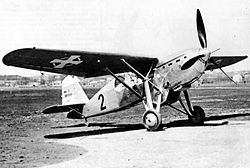
The aircraft of the Yugoslav airline Aeroput, consisting mainly of six Lockheed Model 10 Electras, three Spartan Cruisers, and one de Havilland Dragon were mobilised to provide transport services to the VVKJ.
The Royal Yugoslav Navy
was equipped with one elderly ex-German light cruiser (suitable only
for training purposes), 1 large modern destroyer flotilla leader of
British design, 3 modern destroyers of French design (2 built in
Yugoslavia plus another still under construction), 1 seaplane tender, 4
modern submarines (2 older French-built and 2 British-built) and 10
modern motor torpedo boats (MTBs), of the older vessels, there were 6
ex-Austrian Navy medium torpedo boats, 6 mine-layers, 4 large armoured
river monitors and various auxiliary craft.
Deployment
The Yugoslav Army was organized into three army groups and the
coastal defense troops. The 3rd Army Group was the strongest with the
3rd, 3rd Territorial, 5th and 6th Armies defending the borders with
Romania, Bulgaria and Albania. The 2nd Army Group with the 1st and 2nd Armies, defended the region between the Iron Gates and the Drava River.
The 1st Army Group with the 4th and 7th Armies, composed mainly of
Croatian troops, was in Croatia and Slovenia defending the Italian,
German (Austrian) and Hungarian frontiers.
The strength of each "Army" amounted to little more than a corps,
with the three Army Groups consisting of the units deployed as follows;
The 3rd Army Group's 3rd Army consisted of four infantry divisions and
one cavalry odred; the 3rd Territorial Army with three infantry
divisions and one independent motorized artillery regiment; the 5th Army
with four infantry divisions, one cavalry division, two odred and one
independent motorized artillery regiment and the 6th Army with three
infantry divisions, the two Royal Guards brigades (odred) and three
infantry odred. The 2nd Army Group's 1st Army had one infantry and one
cavalry divisions, three odred and six frontier defence regiments; the
2nd Army had three infantry divisions and one frontier defence regiment.
Finally, the 1st Army Group consisted of the 4th Army, with three
infantry divisions and one odred, whilst the 7th Army had two infantry
divisions, one cavalry division, three mountain odred, two infantry
odred and nine frontier defence regiments. The Strategic, "Supreme
Command" Reserve in Bosnia
comprised four infantry divisions, four independent infantry regiments,
one tank battalion, two motorized engineer battalions, two motorized
heavy artillery regiments, 15 independent artillery battalions and two
independent anti-aircraft artillery battalions. The Coastal Defence
Force, on the Adriatic opposite Zadar comprised one infantry division and two odred, in addition to fortress brigades and anti-aircraft units at Šibenik and Kotor.
On the eve of invasion, clothing and footwear were available for only
two-thirds or so of the potential front-line troops and only partially
for other troops; some other essential supplies were available for only a
third of the front-line troops; medical and sanitary supplies were
available for only a few weeks, and supplies of food for men and feed
for livestock were available for only about two months. In all cases
there was little or no possibility of replenishment.
Beyond the problems of inadequate equipment and incomplete
mobilization, the Yugoslav Army suffered badly from the Serbo-Croat
schism in Yugoslav politics. "Yugoslav" resistance to the invasion
collapsed overnight. The main reason was that none of the subordinate
national groups; Slovenes, Croats were prepared to fight in defence of a
Serbian Yugoslavia. Also, so that the Slovenes did not feel abandoned,
defences were built on Yugoslavia's northern border when the natural
line of defence was much further south, based on the rivers Sava and
Drina. The only effective opposition to the invasion was from wholly
Serbian units within the borders of Serbia itself.
The Germans, thrusting north-west from Skoplje, were held up at Kacanik
Pass and lost several tanks (P39, Buckley C "Greece and Crete 1941"
HMSO 1977). In its worst expression, Yugoslavia's defenses were badly
compromised on 10 April 1941, when some of the units in the
Croatian-manned 4th and 7th Armies mutinied, and a newly formed Croatian government hailed the entry of the Germans into Zagreb the same day. The Serbian General Staff were united on the question of Yugoslavia as a
"Greater Serbia", ruled, in one way or another, by Serbia. On the eve
of the invasion, there were 165 generals on the Yugoslav active list. Of
these, all but four were Serbs.
Operations
Starting on 6 April 1941, Axis armies invaded from all sides and the Luftwaffe bombed Belgrade. German armies were the first to cross the border with Hungarian and Italian armies following a few days later. Tsar Boris III
avoided committing Bulgarian troops to the invasion by claiming that
all of his battle worthy troops were guarding the flank of Germany's 12th Army against Turkey. In a similar manner, while Romania was a staging area for German forces, no Romanian troops were committed to the invasion.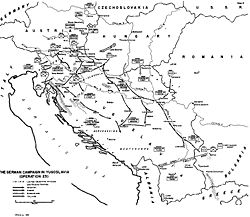
Air operations
Following the Belgrade Coup on 25 March 1941, the Yugoslav armed forces
were put on alert, although the army was not fully mobilised for fear of
provoking Hitler. The VVKJ command decided to disperse its forces away
from their main bases to a system of 50 auxiliary airfields that had
previously been prepared. However many of these airfields lacked
facilities and had inadequate drainage which prevented the continued
operation of all but the very lightest aircraft in the adverse weather
conditions encountered in April 1941.Despite having, on paper at any rate, a substantially stronger force
of relatively modern aircraft than the combined British and Greek air
forces to the south, the VVKJ could simply not match the overwhelming Luftwaffe and Regia Aeronautica superiority in terms of numbers, tactical deployment and combat experience.
The bomber and maritime force hit targets in Italy, Germany
(Austria), Hungary, Romania, Bulgaria, Albania and Greece, as well as
attacking German, Italian and Hungarian troops. Meanwhile the fighter
squadrons inflicted not insignificant losses on escorted Luftwaffe
bomber raids on Belgrade and Serbia, as well as upon Regia Aeronautica
raids on Dalmatia, Bosnia, Herzegovina and Montenegro. The VVKJ also
provided direct air support to the hard pressed Yugoslav Army by
strafing attacking troop and mechanized columns in Croatia, Bosnia and
Serbia (sometimes taking off and strafing the troops attacking the very
base being evacuated).
Little wonder then that after a combination of air combat losses,
losses on the ground to enemy air attack on bases and the overrunning of
airfields by enemy troops, that after 11 days the VVKJ almost ceased to
exist. It must, however, be noted that between 6 and 17 April 1941 the
VVKJ received an additional 8 Hurricane Is, 6 Dornier Do-17Ks, 4 Blenheim Is, 2 Ikarus IK 2s, 1 Rogozarski IK-3 and 1 Messerschmitt Bf 109 from the local aeronautical industry's aircraft factories and work-shops.The VVKJ's Dornier bomber force provides an illustrative case in point.
At the beginning of the April war, the VVKJ was armed with some 60
German designed Do 17Ks, purchased by Yugoslavia in the autumn of 1938,
together with a manufacturing licence. The sole operator was 3 vazduhoplovni puk (3rd bomber regiment) composed of two bomber groups; the 63rd Bomber Group stationed at Petrovec airfield near Skopje and the 64th Bomber Group stationed at Milesevo airfield near Priština. Other auxiliary airfields had also been prepared to aid in dispersal.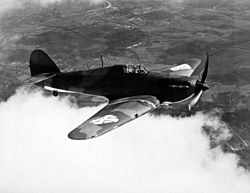 During the course of hostilities, the State Aircraft Factory in Kraljevo
During the course of hostilities, the State Aircraft Factory in Kraljevo
managed to produce six more aircraft of this type. Of the final three,
two were delivered to the VVKJ on 10 April and one was delivered on 12
April 1941.
On 6 April, Luftwaffe dive-bombers and ground-attack fighters
destroyed 26 of the Yugoslav Dorniers in the initial assault on their
airfields, but the remaining aircraft were able to effectively hit back
with numerous multi-ship attacks on German mechanized columns and upon
Bulgarian airfields. By the end of the campaign total Yugoslav losses stood at four destroyed in aerial combat and 45 destroyed on the ground. On 14 and 15 April, the seven remaining Do 17K flew to Nikšić airfield in Montenegro and took part in the evacuation of King Petar II
and members of the Yugoslav government to Greece. During this
operation, Yugoslav gold reserves were also airlifted to Greece by the
seven Do 17s,
as well as by SM-79Ks and Lockheed Electra's but after completing their
mission, five Do 17Ks were destroyed on the ground when Italian
aircraft attacked the Greek-held Paramitia airfield. Only two Do 17Ks
escaped destruction in Greece and later joined the British Royal Air
Force (RAF) in the Kingdom of Egypt.At 16:00 on the 15 April the C-in-C of Luftflotte 4, Generaloberst Alexander Löhr received orders from Hermann Göring to wind down the air-offensive and transfer the bulk of the dive-bomber force to support the campaign in Greece.
A total of 18 bomber, transport and maritime patrol aircraft (two
Dornier Do 17Ks, four Savoia Marchetti SM-79Ks, three Lockheed
Electra's, eight Dornier Do-22Ks and one Rogozarski SIM-XIV-H) succeeded
in escaping to the Allied base in Egypt at the end of the campaign.Bombing of BelgradeLuftflotte 4 of the Luftwaffe, with a strength of seven Combat Formations (Kampfgruppen) had been committed to the campaign in the Balkans. Hitler, infuriated at Yugoslavia's defiance, ordered the implementation of Operation Punishment (Unternehmen Strafgericht). At 7 am
on 6 April the Luftwaffe opened the assault on Yugoslavia by conducting
a saturation-type bombing raid on the capital. Flying in relays from
airfields in Austria and Romania, 300 aircraft, of which a quarter were Junkers Ju 87 Stukas, protected by a heavy fighter escort began the attack. The dive-bombers were to silence the Yugoslav anti-aircraft defences while the medium bombers consisting mainly Dornier Do 17s and Junkers Ju 88
attacked the city. The initial raid was carried out at fifteen-minute
intervals in three distinct waves, each lasting for approximately twenty
minutes. Thus, the city was subjected to a rain of bombs for almost one
and a half hours. The German bombers directed their main effort against
the center of the city, where the principal government buildings were
located. The medium bomber Kampfgruppen continued their attack on the city for several days while the Stuka dive bomber wings (Stukageschwaders) were soon diverted to Yugoslav airfields. When the attack was over, some 4,000 inhabitants lay dead under the
When the attack was over, some 4,000 inhabitants lay dead under the
debris. This blow virtually destroyed all means of communication between
the Yugoslav high command and the forces in the field, although most of
the elements of the general staff managed to escape to one of the
suburbs.
Having thus delivered the knockout blow to the enemy nerve center,
the Luftwaffe was able to devote its maximum effort to military targets
such as Yugoslav airfields, routes of communication, and troop
concentrations, and to the close support of German ground operations.
The VVKJ put up its Belgrade defence interceptors from the six
squadrons of the 32nd and 51st Fighter Groups to attack each wave of
bombers, although as the day wore on the four squadrons from the 31st
and 52nd Fighter Groups, based in central Serbia, also took part. The Messerschmitt 109E,
Hurricane Is and Rogozarski IK-3 fighters scored at least twenty
"kills" amongst the attacking bombers and their escorting fighters on 6
April and a further dozen shot down on 7 April. The desperate defence by
the VVKJ over Belgrade cost it some 20 fighters shot down and 15
damaged.
Ground operations
Three-pronged drive on the Yugoslav capitalThe British, Greek and Yugoslav high commands intended to use Niš as
the lynch-pin in their attempts to wear down German forces in the
Balkans and it is for this reason that the locality was important. When
the Germans broke through in this sector - a sector which was essential
if stability was to be maintained on the front - The Yugoslav Supreme
Command committed numerous forces from its strategic reserves, including
the 2nd Cavalry Division, but these were harassed by the Luftwaffe during transit to the front and did not get through in any real quantities.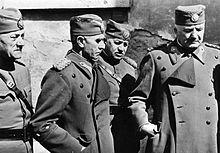
Having reached Niš from its initial attacks from Bulgaria and broken the Yugoslav defences, the German 14th Motorised Corps headed north in the direction of Belgrade. The German 46th Panzer Corps had advanced across the Slavonian plain from Austria to attack Belgrade from the west, whilst the 41st Panzer Corps
threatened the city from the north after launching its offensive drive
from Romania and Hungary. By 11 April, Yugoslavia was criss-crossed by
German armoured columns and the only resistance that remained was a
large nucleus of the Yugoslav Army around the capital. After a day of
heavy fighting German armoured forces broke through these Yugoslav
defences and Belgrade was occupied on the night of 12 April.

Hungarian offensiveOn 12 April the Hungarian Third Army
crossed the border with one cavalry, two motorized and six infantry
brigades. The Third Army faced the Yugoslavian First Army. By the time
the Hungarians crossed the border, the Germans had been attacking
Yugoslavia for over a week. As a result, the Yugoslavian forces
confronting them put up little resistance, except for the units in the
frontier fortifications, who had held up the Hungarian advance for some
time. and inflicted some 350 casualties. Units of the Hungarian Third Army advanced into southern Baranja, located between the rivers Danube and Drava, and occupied the Bačka region in Vojvodina with Hungarian relative majority. The Hungarian forces occupied only those territories which were part of Hungary before the Treaty of Trianon. Showing his disagreement with the Hungarian operations, prime minister Pál Teleki committed suicide.Yugoslav Albanian offensiveIn accordance with the Yugoslav Army's war plan, R-41, a strategy was
formulated that, in the face of a massive Axis attack, a retreat on all
fronts except in the south be performed. Here the 3rd Yugoslav Army, in
cooperation with the Greek Army, was to launch an offensive against the
Italian forces in Albania.
This was in order to secure space to enable the withdrawal of the main
Yugoslav Army to the south. This would be via Albanian territory in
order to reach Greece and the Allied forces to be based there. The
strategy was based on the premise that the Yugoslav Army would, together
with the Greek and British Armies, form a new version of the Salonika Front of World War I.
On 8 April the hard-pressed VVKJ sent a squadron of fourteen Breguet 19 light bombers to the city of Florina in northern Greece to provide assistance to both the Yugoslav and Greek Armies on the Macedonian front. The squadron performed numerous bombing and strafing missions during the course of the campaign.
The 3rd Yugoslav Army of the 3rd Army Group was tasked with
conducting offensive operations against the Italian army in northern
Albania. For this purpose the 3rd Army had concentrated four infantry
divisions and one combined regiment (Odred) in the Montenegro and Kosovo regions:
- 15th Infantry Division "Zetska"
- 13th Infantry Division "Hercegovacka"
- 31st Infantry Division "Kosovska"
- 25th Infantry Division "Vardarska"
- "Komski" cavalry Odred.
The strategic reserve of the 3rd Army Group, the 22nd Infantry Division "Ibarska", was situated around Uroševac in the Kosovo region.
In addition, offensive operations against the Italian enclave of Zara
(Zadar) on the Dalmatian coast were to be undertaken by the 12th
Infantry Division "Jadranska".The first elements of the 3rd Army launched their offensive
operations in North Albania on 7 April 1941, with the Komski Odred
covering the Gusinje-Prokletije mountains area advancing towards the
village of Raja-Puka. The Kosovska Division crossed the border in the Prizren area of Kosovo and was advancing through the Drin River valley. The Vardarska Division gained some local success at Debar, while the rest of the army's units were still assembling.
The next day, the 8th, found the Zetska Division steadily advancing along the Podgorica–Shkodër
road. The Komski cavalry Odred successfully crossed the dangerous
Prokletije mountains and reached the village of Koljegcava in the
Valjbone River Valley. South of them the Kosovska Division broke through
the Italian defences in the Drin River Valley, but due to the fall of
Skopje to the attacks by the German Army, the Vardarska Division was
forced to stop its operations in Albania.
The 9 April 1941 saw little further progress for the Yugoslavs,
because although the Zetska Division continued advancing towards Shkodër
and the Komski Odred reached the Drin River, the Kosovska Division had
to halt all combat activities on the Albanian Front due to the
appearance of German troops in Prizren.On 10 April 1941 the Zetska Division was still steadily fighting its way
towards Shkodër and had advanced 50 km in some places. These advances
had been supported by aircraft of the VVKJ's 66th and 81st Bomber
Groups, who attacked airfields and Italian troop concentrations around
Shkodër, as well as the port of Durrës.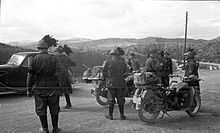 The Komski Odred and the right column of the Kosovska Division
The Komski Odred and the right column of the Kosovska Division
advanced along the right bank of the Drin River towards Shkodër in order
to link with Zetska Division, but the central and left column of the
Kosovska Division were forced to take a defensive perimeter to hold off
the increasing pressure by German troops.
Between 11–13 April 1941, with German and Italian troops advancing on
its rear areas, the Zetska Division was forced to retreat back to the
Pronisat River by the Italian 131st Centauro Armoured Division, where it remained until the end of the campaign on 16 April. The Centauro Division then advanced upon the Yugoslav fleet base of Kotor in Montenegro, also occupying Cettinje and Podgorica.
Naval operations
When Germany and Italy attacked Yugoslavia on 6 April 1941, The Yugoslav Royal Navy had available three destroyers, two submarines and 10 MTBs as the most effective units of the fleet. One other destroyer, the Ljubljana
was in dry-dock at the time of the invasion and she and her
anti-aircraft guns were used in defence of the fleet base at Kotor. The
remainder of the fleet was useful only for coastal defence and local
escort and patrol work.,_jugoslawische_Schiffe.jpg/220px-Bundesarchiv_Bild_101I-185-0116-27A,_Bucht_von_Kotor_(-),_jugoslawische_Schiffe.jpg) Kotor was close to the Albanian border and the Italo-Greek front there,
Kotor was close to the Albanian border and the Italo-Greek front there,
but Zara (Zadar), an Italian enclave, was to the north-west of the coast
and to prevent a bridgehead being established, the destroyer Beograd,
four of the old torpedo boats and 6 MTBs were despatched to Šibenik,
80 km to the south of Zara, in preparation for an attack. The attack was
to be co-ordinated with the 12th "Jadranska" Infantry Division and two
"Odred" (combined regiments) of the Yugoslav Army attacking from the Benkovac
area, supported by air attacks by the 81st Bomber Group of the VVKJ.
The Yugoslav forces launched their attack on 9 April but by 13 April the
Italian forces had counter-attacked and were in Benkovac by 14 April. The naval prong to this attack faltered when the destroyer Beograd
was damaged by near misses from Italian aircraft off Šibenik when her
starboard engine was put out of action, after which she limped to Kotor,
escorted by the remainder of the force, for repair.The maritime patrol float-planes of the VVKJ flew reconnaissance and
attack missions during the campaign, as well as providing air cover for
mine-laying operations off Zara (Zadar). Some of their successes
included an Italian tanker being damaged by a near miss off the Italian
coast near Bari,
attacks on the Albanian port of Durrës, as well as strikes against
Italian re-supply convoys to Albania. On 9 April, one Dornier Do 22K
floatplane notably took on an Italian convoy of 12 steamers with an
escort of eight destroyers crossing the Adriatic during the day,
attacking single-handed in the face of intense AA fire.
in its riverine flotilla. They were used to patrol the Danube, Drava
and Sava rivers in the northern parts of Yugoslavia and its border with
Hungary. These monitors, the Drava, Sava, Morava and Vardar
had been inherited from the Austrian Navy at the end of World War I.
All were of around 400-500t with a main armament of two 120 mm guns, two
or three 66 mm guns, 120 mm mortars, 40 mm AA guns and machine guns. At the start of the campaign they had carried out offensive operations by shelling the airfield at Mohács in Hungary on 6 April and again two days later, but had to begin withdrawing towards Novi Sad by 11 April after coming under repeated attack by German dive-bombers.
Aftermath
The Axis victory was swift. On 17 April 1941, Yugoslavia surrendered
after only eleven days. The insistence of the Yugoslav Army on trying to
defend all the borders did not help matters. Yugoslavia was
subsequently divided amongst Germany, Hungary, Italy and Bulgaria, with
most of Serbia being occupied by Germany. The Italian-backed Croatian fascist leader Ante Pavelić declared an Independent State of Croatia before the invasion was even over.
Beginning with the uprising in Serbia in July 1941, there was continuous resistance to the occupying armies in Yugoslavia, mainly by the Partisans and to a lesser extent by the Chetniks.

Blitzkrieg Map Editor
Mapping Tool 4 commentsWith this Map Editor you can create maps for singleplayer & multiplayer mods.










This comment is currently awaiting admin approval, join now to view.